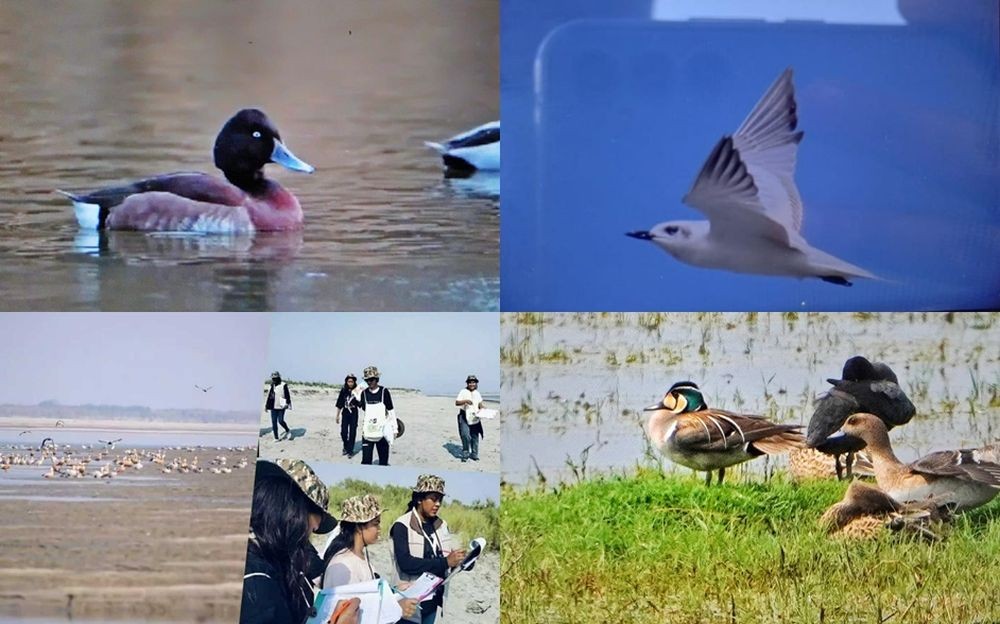IANS Photo

Guwahati, January 13 (IANS) The Kaziranga National Park and Tiger Reserve (KNPTR), India's seventh UNESCO world heritage site famous for its one-horned rhinos, and home to more than 2,613 one-horned Indian rhinos and other animals including tiger and elephants, has recorded a 27 per cent increase in the number of resident and winter migratory waterbirds.
The two-day fifth waterbird census, findings of which were revealed on Friday, conducted through the citizen scientist initiative from January 9 across the 1,302 sq km wildlife reserve, confirmed the presence of 84,839 birds, which was 18,063 more than the number recorded during a corresponding survey in 2021-22.
KNPTR officials said that the Kaziranga is now among the top five habitats of waterbirds in the country.
Kaziranga's Field Director, Sonali Ghosh, said that this time the bird census was conducted in major wetlands adjoining the tiger reserve along with the water bodies within the reserve.
"In the Kaziranga-Hukuma Beel in Biswanath found 3,049 birds while the Joysagar Doloni in Kaliabor recorded 1,765 birds, highlighting their conservation and protection," she said.
Other prominent wetlands adjoining the KNPTR that recorded significant bird presence were Gonak Beel (973), Sahala Beel (424), and Sisubari Beel (348).
The bird census, which was launched by Assam Environment and Forest Minister Chandra Mohan Patowary on January 9, was conducted simultaneously across 115 water bodies in three divisions of the KNPTR.
The three divisions are -- Eastern Assam Wildlife, Nagaon Wildlife and Biswanath Wildlife.
In all, 108 enumerators and 354 volunteers as well Forest officials and staff were involved in conducting the survey.
During the survey, 37,606 birds across 155 species were recorded in the Eastern Assam Wildlife Division followed by 35,231 birds of 98 species in Nagaon Wildlife division and 12,002 birds across 82 species were spotted in the Biswanath Wildlife Division.
Some of the unique, rare, and endangered species reported during the January 9-10 survey were Baer's pochard, Baikal teal, greater scaup, gull-billed tern, greater white-fronted goose, great crested grebe, Pallas' gull, black stork, black-headed gull, and cotton pygmy goose.
In the first census in 2018, a total of 10,412 waterfowl belonging to 80 different species were recorded in Kaziranga while the second survey in 2020 revealed a total of 34,284 birds belonging to 98 species while 93,491 birds belonging to 112 species were recorded in 2021.
According to the officials, with its unique terrestrial and aquatic habitats, Kaziranga is one of the best-protected preserves in the world.
Besides being the home of the major five mammals -- rhino, tiger, elephant, Asiatic water buffalo, and eastern swamp deer -- the KNPTR is a world famous destination for bird watchers as it sustains more than 500 avian species.
More than half of its landmass under grasslands is dotted with water bodies, locally known as 'beel'.
These, along with the Brahmaputra river along the park and tributaries such as Dhansiri, Difloo, and Laokhowa Suti provide an ideal habitat for resident and migratory birds.
The KNPTR's natural significance made the Bombay Natural History Society and Bird Life International list it as an Important Bird Area a few years ago.


.jpg)



